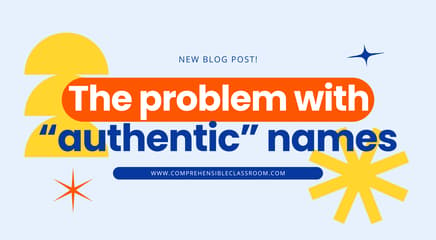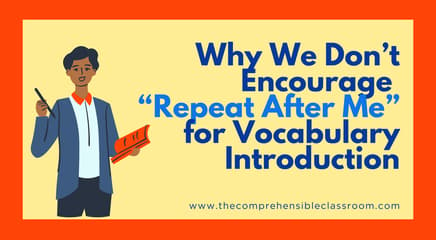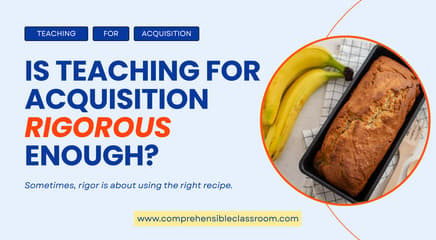I am a very bossy person by nature, and unfortunately I didn't realize it until right after I graduated from high school. By the grace of God, I've learned how to tame my nasty natural instincts...although it's not always easy! Being married helps :)
I think that this is why the game that I'm about to explain is my favorite game ever. It's a mind game, and I'm in control. I get to tell people "Yes" or "No", and they have to live with my verdict. I get to go on a power trip, but everyone thinks that it's fun. MUAH HA HA!!!

The name of the game: I'm going on a trip!
You've probably played this game in one of its many versions before, but perhaps you have not considered how to apply it to the language classroom. I'll explain the rules, several possible scenarios, and then I'll wait for your comments to find out even more ways that we can use it to further our students' language acquisition!!
The premise of the game
The students are going on a trip and have to figure out what they can/can't bring. Only the teacher (game master) knows the criterion that an object must meet in order to go along with the student on the trip.
How to play "I'm going on a trip"
- The teacher tells the class that they are going to go on an imaginary trip. The class decides where they want to go.
- The teacher tells students that they can only bring certain items on the trip, and that any object they bring must meet a specific criterion. Their goal is to figure out what the criterion is, but they must never say what they think the criterion is when they think they know it. They must use guess and check to confirm their hypothesis.
- The teacher gives students one example of an object that can be brought on the trip decided on by the class, enclosed in a model statement. For example, "I'm going to Hawaii, and I'm going to bring [a swimsuit]".
- The teacher writes the model statement on the board, then turns it into a question and reflects it back to the class. For example, "What are you going to bring to Hawaii?"
- Students take turns saying what they are going to bring to Hawaii, always following the model statement exactly. "I'm going to Hawaii, and I'm going to bring [a palm tree]". "I'm going to Hawaii, and I'm going to bring [my boyfriend]". They can say anything.
- After each statement, the teacher responds "Yes, you can" or "No, you can't".
How to help students figure out the key
Students continue saying what they will bring, with the teacher confirming or denying their idea. Every once in awhile, the teacher throws in an example that works in order to help the class. At first, they should be examples that confuse the kids--bring ridiculous things like buildings, countries, whatever! The examples should get more and more obvious as the game goes on in an effort to help all students to figure out the criterion. Use inflection, body language, etc. to help students figure it out!
Again, students must never say out loud what they think the criterion is, but instead confirm their hypothesis by volunteering more statements. Once they have it, you will know (and they will too) because they will be allowed to bring everything that they volunteer.
Ideally, you end the game when all students have figured out the trick...you may need to "cheat" to help all students get there, depending on how difficult the criterion is with which you play.
Possible Criterion for "I'm going on a trip"
Here are some possible criteria that you can use to play the game. You only use one per game!!
UMMMM....
You must say "Um" or "Uh" before you make the statement. (This is my favorite!) Ex: "Um....I'm going to Hawaii, and I'm going to bring a castle". In order for this to work well, however, it is best if the teacher calls on random students as opposed to having students raise their hands. If kids have planned out what they are going to say, they will not often say "Um". Your students that are excellent at public speaking may get frustrated because they don't use fillers, and so they won't ever be allowed to bring the items that they suggest!
ALPHA ORDER
The items must go in alphabetical order. For example, "I'm going to Hawaii, and I'm going to bring an Apple" "I'm going to Hawaii, and I'm going to bring a Boat" "I'm going to Hawaii, and I'm going to bring a Chunk of cheese". Start from a letter in the middle of the alphabet to make it less obvious, and use words whose initial letters are disguised in sound, like "Xylophone" or "Phenomenal".
ALPHA CHAIN
The items must begin with the last letter of the previously accepted item: ex: ApplE, ElephanT, TrampolinE, EgG, GoD, DoG...
WORD LENGTH
The items must all consist of the same number of letters: food, door, cars, hand, etc. You would probably want to plan out a list of these ahead of time for you to use as examples, because it isn't easy to think of them on the spot.
CATEGORIES
The items all fit into a specific category--things that are round, things that are red, things that are awake in the night, things that have doors, etc.)
THAT'S NOT FAIR!
The person saying the sentence fits into a specific category--boys only, students with birthdays in August-December, students that speak another language in addition to English + TL, etc.
Play with different sentence frames!
Here are some possible language structures that you can use to practice it in different units and levels:
- I go to __ and I bring __
- I'm going to go to __ and I'm going to bring __
- I want to go to __ and I want to bring __
- I'm thinking about going to __ and I'm thinking about bringing __.
- I went to __ and I brought __
- If I were to go to __, I would bring __.
- When I used to go to __, I used to bring __.
- When you go to __, I recommend that you bring __.
You can also change the subject to "WE are going to __ and I/We/my friend am/are/is going to bring", and you can change the verbs used (flying to, traveling to, etc.; I live in __ and I have __; I'm packing my suitcase and I put ___ in it). The possibilities are endless!
Have a BLAST!
Hope your students love this game as much as my students and I do! I'd love to hear more ideas for how to play it differently in the comments section!





